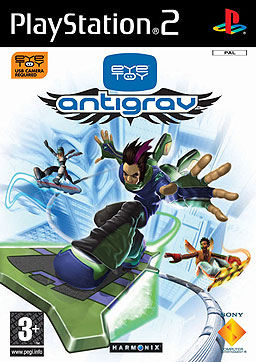EyeToy: AntiGrav
| EyeToy: Antigrav | |
|---|---|
 | |
| Developer(s) | Harmonix |
| Publisher(s) | Sony Computer Entertainment America |
| Designer(s) | Greg LoPiccolo, Rob Kay, Chris Canfield, Benjamin Schneider, Jason Warburg, A. J. Wolosenko |
| Series | EyeToy |
| Platform(s) | PlayStation 2 |
| Genre(s) | Extreme Sports |
| Mode(s) | Single player |
EyeToy: AntiGrav is a hoverboard game by Sony, released in early November 2004. It was touted as the first "real" game for EyeToy targeted to more seasoned gamers. The earlier games such as Play and Groove were geared towards younger kids for family or party fun. Unlike the earlier EyeToy games, the player's image is not shown inside the Antigrav game. Instead, the player's movement is reflected in the animated character in the game. The player moves his body to control the on-screen hoverboard rider to go through an obstacle course. The player needs to make turns and jump over or duck under obstacles by moving his body in front of the EyeToy. The game allows one player at a time, but supports up to four players taking turns.
When the game was first released in the USA in November 2004, it was bundled with the EyeToy hardware. The European release was due in March 2005.
Gameplay
There are a total of 5 tracks:
The Falls: The main city in the game, with a section passing through a series of waterfalls.
Water Front: An industrial/Chinatown area, going through tunnels and ending up in a harbour
Skyway: A race around, above and through a series of skyscrapers. One of the most highlights of the course is a section where the player races down a building into oncoming traffic.
Aerodome: A lap based track with several "tiers" to work up. The higher the tier, the more "shortcuts" are available to the player.
Black Rock Ridge: The longest and most difficult course. It starts at the top of a snow-capped mountain remnicent of typical snowboarding games. As the player descends the mountain, the temperature gets milder into a fall foliage atmosphere.
There was a demo in Eye Toy Play 2 for this game. it only had one character and one stage.
Characters
There are eight standard characters, each representing one of four "clans". Each clan has an associated colour and "animal" which is reflected in the rider's clothing and wings. There is no difference between the characters in terms of performance; they only differ in appearance, phrases, "super-tricks" and board type. There are also 3 hidden characters; two are unlocked by clearing both speed and style modes, while the last is unlocked when a player gets a three star ranking (or better) on all courses.
Clan: Stinger
Colour: Purple/Green
Animal: Bee
Riders:
Tetsuo - The scarfed rider who appears as the central focus on the game cover
Tantrum - A short, long-sleeved rider with an eccentric personality
Clan: Talon
Colour: Light Blue
Animal: Eagle
Riders:
Jett - A rider with a mechanically enhanced left arm
Skye - A female rider with a British Accent. Her super-trick is the "Bangers & Mash"
Clan: Sonar
Colour: Dark Blue
Animal: Bat
Riders:
Nomad - A tatooed, punk style rider
Luna - A Goth-inspired rider
Clan: Scarab
Colour: Orange
Animal: Scarab Beetle
Riders:
Compound - A gasmask wearing, overly large rider
Mika - A rider with ladybug-like wings, she appears on the background of the cover
Clan: None (Hidden Characters)
Drone - An insect-like rider who speaks in reverse
Crimson d - A terminator-like robotic rider
Music
As a game developed by Harmonix, much effort was put into the music and sound effects for the game. The tracks are performed by Apollo 440, and the soundtrack changes according to what the player is doing in the game. For example, when a player is flying, the music will change to a slower, more relaxed edit of the song.
Reception
The game received mixed reviews, with a Metacritic average of 71.[2]
